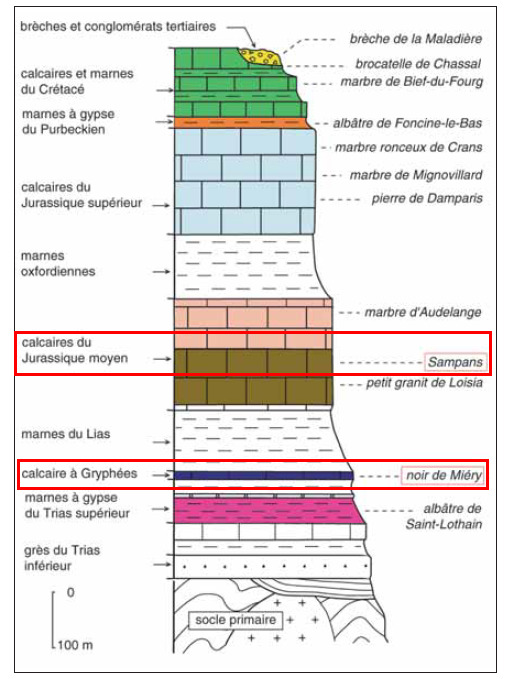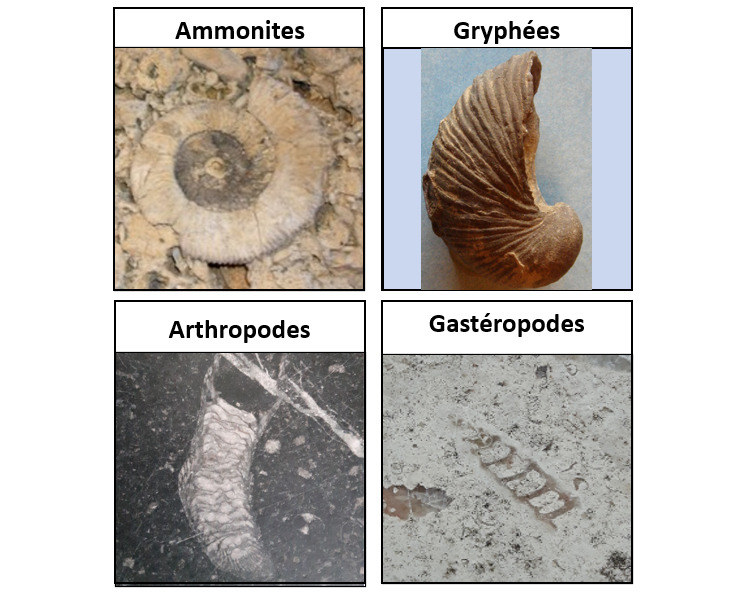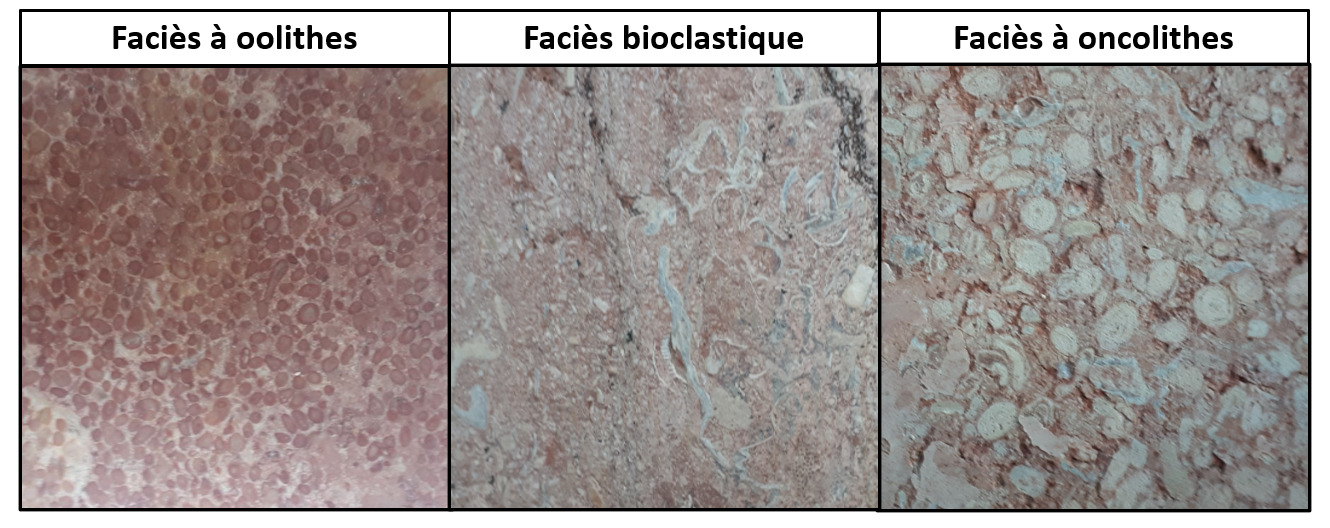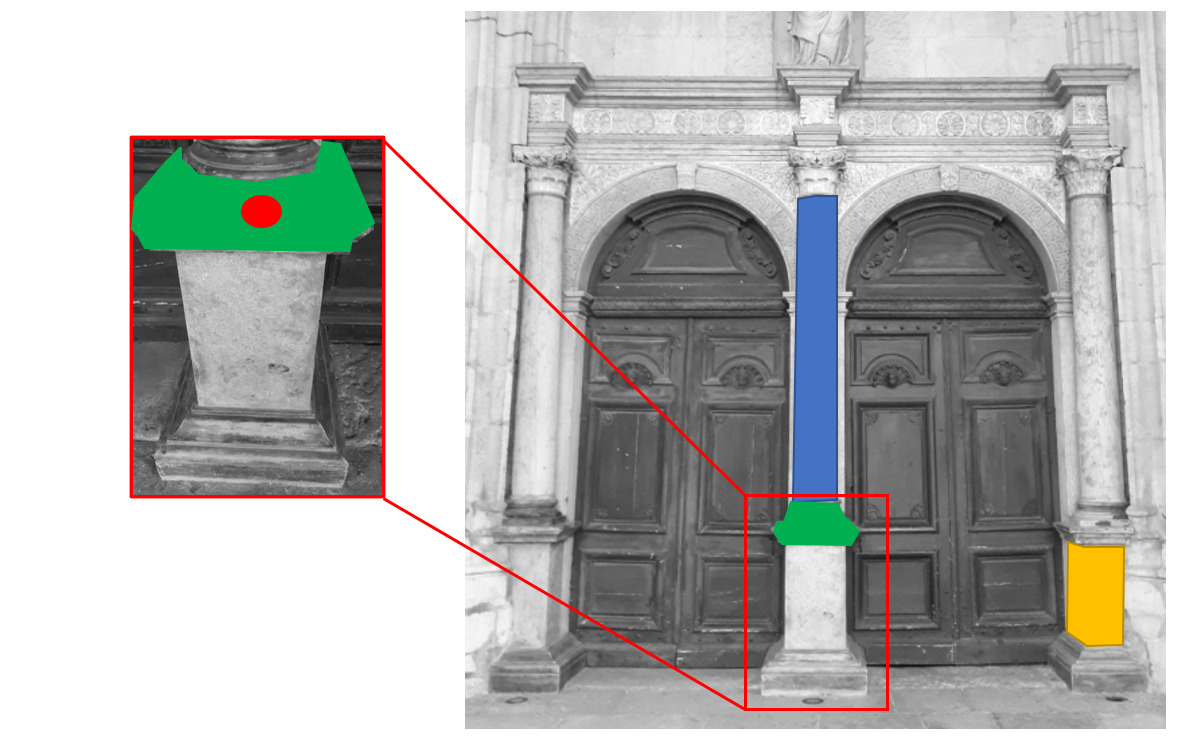
La Earthcache / The Earthcache
La Collégiale Notre-Dame de Dole utilise pour ses parements des marbres régionaux.
► Les Marbres du Jura
Le Jura est réputée pour l'extraction de nombreuses pierres marbrières.
Ici, le terme de marbre est utilisé au sens esthétique de pierre poli, car les marbres du Jura sont tous des calcaires jurassiques et non des marbres au sens géologique du terme (formations carbonatées ayant subit une métamorphisation avec recristallisation du CaCO3).

Ces formation secondaires sont issues de la diagenèse (consolidation) de sédiments marins (débris fossiles) qui se sont colorés avec divers minéraux, leur donnant un rendu esthétique.
Partons à la découvert de deux calcaires marbriers utilisés pour le porche de la Collégiale.
► Le Marbre de Miéry
La région de Miéry présente une succession de formations secondaires ayant été déformées pendant l'orogenèse de la chaîne jurassienne pendant le Cénozoïque.
Ces formations sont issues d'une vaste transgression marine survenue au Jurassique inférieur (Lias), permettant la mise en place d'une mer chaude et peu profonde.
Dans ces fond benthiques vont se déposer de nombreux fossiles : ammonites, arthropodes, gastéropodes et surtout des huîtres arquées, les Gryphées (Gryphea arcuata), caractéristiques du Sinémurien (-190 Ma) ce qui en fait un fossile stratigraphique (marqueur de datation).

La diagenèse de ces dépôts donne un calcaire sombre et dur, cristallin, de couleur bleue (Pierre bleue de Miéry) ou noire (Noir de Miéry), à grains très fins donnant un poli très lisse.
Il est parsemé de section de fossiles blancs centimétriques tranchant sur le fond sombre.

► Le Marbre de Sampans
Il s'agit d'une formation locale, la zone de Sampans se trouvant à quelques kilomètres de Dôle affleurant sous la forme de bandes sur la bordure tectonisée à l’ouest du massif de la Serre.
Une régression de la fin du Lias met en place des plates-formes carbonatées peu profondes au Jurassique moyen alternant avec des périodes sans sédimentation. C'est lors d'une phase transgressive au Bajocien Supérieur (-172 Ma) que se met en place la formation de Sampans.
La principale caractéristique de cette formation est sa couleur, d'un rouge profond.
Dans la région de Dole, ces teintes rouges très soutenues résulte d'imprégnations ou d'oxydations du fer liées au rôle drainant des failles responsables de la remontée du horst de la Serre.
Ce marbre se décline en plusieurs faciès, variant selon la coloration et la constitution :
~ Le faciès oolithique
Il constitue la partie basale de la formation.
De couleur blanchâtre à rosé, il est composé d'oolithes bien calibrés (sphères d'origine chimique d'un demi-millimètre de diamètre) dans une matrice calcite homogène colmatant les espaces ce qui donne une texture fine et lisse à la pierre.
~ Le faciès bioclastique
Il s'agit du faciès typique du marbre de Sampans avec une teinte dominante de couleur rouge vif liée à une forte proportion d'oxydes de fer.
Ce faciès contient de nombreux débris de coquilles calcaires de quelques millimètres, donnant une texture plus grossière à la roche au toucher.
~ Le faciès oncolithique
Il s'agit d'un faciès atypique, surnommé "grains d'orge" du fait de la forme de ses sédiments pluri-millimétriques disposés de manière très dense avec une fine matrice calcaire les cimentant.
Ceux-ci sont principalement des tests d'oncolithes entourés d'un revêtement calcaire concentrique.

The Collegiate Church of Notre-Dame de Dole uses regional marble for its facings.
► The Marbles of Jura
The Jura is famous for the extraction of many marble stones.
Here, the term marble is used in the aesthetic sense of polished stone, because the Jura marbles are all Jurassic limestones and not marbles in the geological sense of the term (carbonate formations that have undergone metamorphosis with recrystallization of CaCO3).
These secondary formations result from the diagenesis (consolidation) of marine sediments (fossil debris) which are colored with various minerals, giving them an aesthetic rendering.
Let's go and discover two limestone marble used for the porch of the Collegiate Church.
► The Marble of Miéry
The Miéry region presents a succession of secondary formations that were deformed during the orogeny of the Jura chain during the Cenozoic.
These formations are the result of a vast marine transgression that occurred in the Lower Jurassic (Lias), allowing the establishment of a warm and shallow sea.
In these benthic bottoms, many fossils will be deposited: ammonites, arthropods, gastropods and especially arched oysters, the Grypheus (Gryphea arcuata), characteristic of the Sinemurian (-190 Ma) which makes it a stratigraphic fossil (dating marker).
The diagenesis of these deposits gives a dark and hard limestone, crystalline, blue (Pierre Bleue de Miéry) or black (Noir de Miéry), with very fine grains giving a very smooth polish.
It is dotted with section of centimeter-sharp white fossils against the dark background.
► The Sampans Marble
It is a local formation, the Sampans area lying a few kilometers from Dôle outcropping in the form of bands on the tectonized border to the west of the Serre massif.
A regression of the end of the Lias sets up shallow carbonate platforms in the Middle Jurassic alternating with periods without sedimentation. It is during a transgressive phase in the Upper Bajocian (-172 Ma) that the formation of Sampans takes place.
The main characteristic of this formation is its color, a deep red.
In the region of Dole, these very strong red tints result from impregnations or oxidation of iron linked to the draining role of the faults responsible for the rise of the Serre horst.
This marble comes in several facies, varying according to color and constitution:
~ The oolitic facies
It constitutes the basal part of the formation.
Whitish to pink in color, it is composed of well calibrated ooliths (spheres of chemical origin half a millimeter in diameter) in a homogeneous calcite matrix clogging the spaces which gives a fine and smooth texture to the stone.
~ The bioclastic facies
This is the typical facies of Sampans marble with a dominant color of bright red color linked to a high proportion of iron oxides.
This facies contains many debris of limestone shells of a few millimeters, giving a coarser texture to the rock to the touch.
~ The oncolithic facies
This is an atypical facies, nicknamed "barley grains" because of the shape of its pluri-millimeter sediments arranged very densely with a fine limestone matrix cementing them.
These are mainly tests of oncoliths surrounded by a concentric limestone coating.
► Sources bibliographiques / Bibliographical sources
Les Questions / The Questions
Questions pour valider :"Quels Marbres Jurassiens à la Collégiale ?"
Questions to validate: "Which Jurassic Marbles at the Collegiate Church?"
- Question 0 : Prenez une photo de vous ou d'un élément vous identifiant devanr la Collégiale, mais sans le porche de l'église.
Cette photo devra au choix nous être transmise avec les réponses ou être ajoutée à votre log.
-Question 0 : Take a photo of yourself or something that identifies you in front of the Collegiate Church, but without the church porch.
This photo must either be sent to us with the answers or added to your log.
Vous voici sous l'imposant porche de la Collégiale, devant les portes de l'entrée principale. Observons dans le détail les marbres utilisés pour les colonnades de cette entrée (photo WP1).
Here you are under the imposing porch of the Collegiate Church, in front of the doors of the main entrance. Let us observe in detail the marbles used for the colonnades of this entrance (photo WP1).

- Question 1 : Décrivez la roche sous la zone bleue de la colonne du milieu. Déduisez-en sa nature puis son faciès.
- Question 1: Outline the rock under the blue area of the middle column. Deduce its nature then its facies.
- Question 2 : Décrivez la roche sous la zone jaune (partie basale de la colonne de droite). Déduisez-en sa nature puis son faciès.
- Question 2 : Describe the rock under the yellow area (basal part of the right column). Deduce its nature then its facies.
- Question 3 : Décrivez la roche de la zone verte (partie médiane de la colonne du milieu). Déduisez-en sa nature.
- Question 3 : Describe the rock in the green zone (middle part of the middle column). Deduce its nature.
- Question 4 : Au centre de cette zone verte, sous le rond rouge, quel fossile voyez-vous ? Quel qualificatif peut-on donner lui donner ?
- Question 4 : In the center of this green area, under the red circle, which fossil do you see? What qualifier can we give it?
Vous pouvez vous loguer sans attendre notre confirmation,
mais vous devez nous envoyer les réponses en même temps soit par mail via notre profil (
fafahakkai), soit via la messagerie geocaching.com (Message Center).
S'il y a des problèmes avec vos réponses nous vous en ferons part.
Les logs enregistrés sans réponses seront supprimés.
You can log this cache without waiting for our confirmation, but you must send us the answers at the same time, by e-mail via our profile (fafahakkai) or by the system of Message Center of geocaching.com.
If there is a problem with your answers we will notify you. The logs recorded without answers will be deleted.
Rappel concernant les « Earthcaches »: Il n'y a pas de conteneur à rechercher ni de logbook à renseigner. Il suffit de se rendre sur les lieux, de répondre aux questions ci-dessus et de nous renvoyer les réponses.
Reminder concerning "Earthcaches": there is neither a container to look for nor a logbook to sign. One need only go to the location, answer to the differents questions and send us the answers.